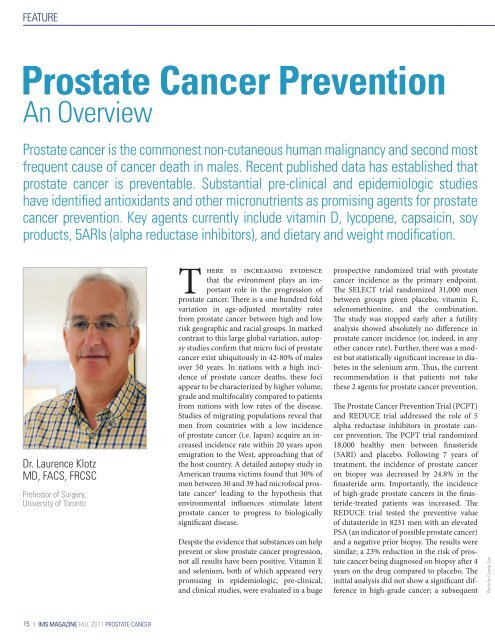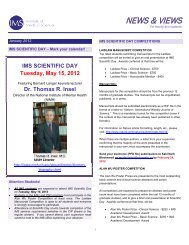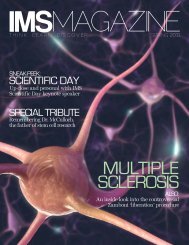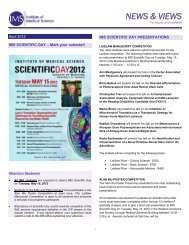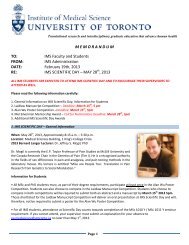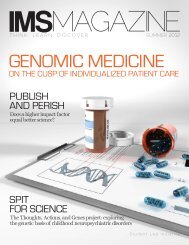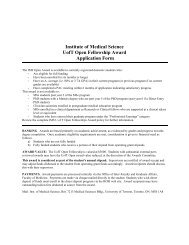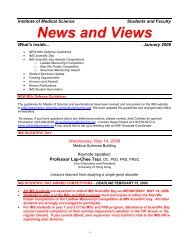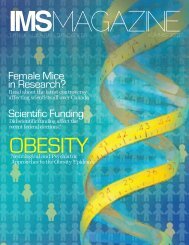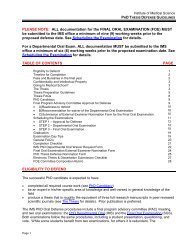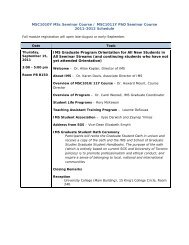Fall 2011 - Institute of Medical Science - University of Toronto
Fall 2011 - Institute of Medical Science - University of Toronto
Fall 2011 - Institute of Medical Science - University of Toronto
You also want an ePaper? Increase the reach of your titles
YUMPU automatically turns print PDFs into web optimized ePapers that Google loves.
FEATURE<br />
Prostate Cancer Prevention<br />
An Overview<br />
Prostate cancer is the commonest non-cutaneous human malignancy and second most<br />
frequent cause <strong>of</strong> cancer death in males. Recent published data has established that<br />
prostate cancer is preventable. Substantial pre-clinical and epidemiologic studies<br />
have identified antioxidants and other micronutrients as promising agents for prostate<br />
cancer prevention. Key agents currently include vitamin D, lycopene, capsaicin, soy<br />
products, 5ARIs (alpha reductase inhibitors), and dietary and weight modification.<br />
Dr. Laurence Klotz<br />
MD, FACS, FRCSC<br />
Pr<strong>of</strong>essor <strong>of</strong> Surgery,<br />
<strong>University</strong> <strong>of</strong> <strong>Toronto</strong><br />
T<br />
here is increasing evidence<br />
that the evironment plays an important<br />
role in the progression <strong>of</strong><br />
prostate cancer. There is a one hundred fold<br />
variation in age-adjusted mortality rates<br />
from prostate cancer between high and low<br />
risk geographic and racial groups. In marked<br />
contrast to this large global variation, autopsy<br />
studies confirm that micro foci <strong>of</strong> prostate<br />
cancer exist ubiquitously in 42-80% <strong>of</strong> males<br />
over 50 years. In nations with a high incidence<br />
<strong>of</strong> prostate cancer deaths, these foci<br />
appear to be characterized by higher volume,<br />
grade and multifocality compared to patients<br />
from nations with low rates <strong>of</strong> the disease.<br />
Studies <strong>of</strong> migrating populations reveal that<br />
men from countries with a low incidence<br />
<strong>of</strong> prostate cancer (i.e. Japan) acquire an increased<br />
incidence rate within 20 years upon<br />
emigration to the West, approaching that <strong>of</strong><br />
the host country. A detailed autopsy study in<br />
American trauma victims found that 30% <strong>of</strong><br />
men between 30 and 39 had micr<strong>of</strong>ocal prostate<br />
cancer 1 leading to the hypothesis that<br />
environmental influences stimulate latent<br />
prostate cancer to progress to biologically<br />
significant disease.<br />
Despite the evidence that substances can help<br />
prevent or slow prostate cancer progression,<br />
not all results have been positive. Vitamin E<br />
and selenium, both <strong>of</strong> which appeared very<br />
promising in epidemiologic, pre-clinical,<br />
and clinical studies, were evaluated in a huge<br />
prospective randomized trial with prostate<br />
cancer incidence as the primary endpoint.<br />
The SELECT trial randomized 31,000 men<br />
between groups given placebo, vitamin E,<br />
selenomethionine, and the combination.<br />
The study was stopped early after a futility<br />
analysis showed absolutely no difference in<br />
prostate cancer incidence (or, indeed, in any<br />
other cancer rate). Further, there was a modest<br />
but statistically significant increase in diabetes<br />
in the selenium arm. Thus, the current<br />
recommendation is that patients not take<br />
these 2 agents for prostate cancer prevention.<br />
The Prostate Cancer Prevention Trial (PCPT)<br />
and REDUCE trial addressed the role <strong>of</strong> 5<br />
alpha reductase inhibitors in prostate cancer<br />
prevention. The PCPT trial randomized<br />
18,000 healthy men between finasteride<br />
(5ARI) and placebo. Following 7 years <strong>of</strong><br />
treatment, the incidence <strong>of</strong> prostate cancer<br />
on biopsy was decreased by 24.8% in the<br />
finasteride arm. Importantly, the incidence<br />
<strong>of</strong> high-grade prostate cancers in the finasteride-treated<br />
patients was increased. The<br />
REDUCE trial tested the preventive value<br />
<strong>of</strong> dutasteride in 8231 men with an elevated<br />
PSA (an indicator <strong>of</strong> possible prostate cancer)<br />
and a negative prior biopsy. The results were<br />
similar; a 23% reduction in the risk <strong>of</strong> prostate<br />
cancer being diagnosed on biopsy after 4<br />
years on the drug compared to placebo. The<br />
initial analysis did not show a significant difference<br />
in high-grade cancer; a subsequent<br />
Photo by Connie Sun<br />
15 | IMS MAGAZINE FALL <strong>2011</strong> PROSTATE CANCER


